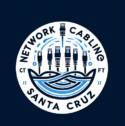What Are the Four Types of Network Cables? A Complete Guide for Home and Business Networks
If you’ve ever set up a computer network or connected a device to the internet, you’ve used a network cable — even if you didn’t realize it. Network cables are the physical connections that carry data between devices like computers, routers, switches, and servers. But not all cables are created equal.
In this guide, we’ll explain the four main types of network cables, how they differ, and which one is best for your home or business setup. Our skilled structured cabling experts in Santa Cruz ensure every installation uses the right cable type for maximum efficiency and reliability.
1. Ethernet Cables (Twisted Pair)
The most common type of network cable used today is the Ethernet cable, also known as a twisted pair cable. It’s made up of pairs of copper wires twisted together to reduce electromagnetic interference.
There are several categories (or “Cat” ratings) of Ethernet cables:
- CAT5e: Supports up to 1 Gbps speeds and is widely used in residential settings.
- CAT6: Supports up to 10 Gbps at shorter distances — great for offices and small businesses.
- CAT6a: Enhanced version of CAT6 that performs better over longer distances.
- CAT7 and CAT8: High-performance options used in data centers and enterprise networks.
Best for: Home networks, offices, VoIP systems, and most standard internet connections.
Why choose it: Affordable, reliable, and compatible with most networking equipment.
2. Coaxial Cables
Coaxial cables, often called coax cables, have been around for decades and are still used for certain types of internet and television connections. They consist of a single copper conductor surrounded by insulation, shielding, and an outer plastic layer.
Although not as common for modern Ethernet networks, coaxial cables are still used in:
- Cable TV systems
- Broadband internet connections (from ISPs)
- CCTV security camera setups
Best for: Television, internet from cable providers, and older CCTV systems.
Why choose it: Strong signal protection and excellent for long-distance video or internet transmission.
3. Fiber Optic Cables
Fiber optic cables are the fastest and most advanced type of network cable. Instead of transmitting electrical signals through copper, they use light pulses to transfer data. This allows for extremely high speeds and long-distance transmission with minimal signal loss.
Fiber cables come in two main types:
- Single-mode fiber (SMF): Best for long-distance communication — used by ISPs and enterprise networks.
- Multi-mode fiber (MMF): Ideal for shorter distances — commonly used in offices and data centers.
Best for: Data centers, enterprise networks, ISPs, and high-speed internet connections.
Why choose it: Lightning-fast speeds, resistance to interference, and support for future technologies. Before diving into the four main types, it’s helpful to review the three basic types of cabling commonly used in structured wiring systems.
4. USB Cables
While not often thought of as traditional network cables, USB (Universal Serial Bus) cables can connect and share data between computers, peripherals, and even network adapters. Many modern devices — like printers, cameras, and external drives — use USB connections for both power and data transfer.
Best for: Peripheral connections, device-to-device data transfer, and mobile network tethering.
Why choose it: Convenient, versatile, and supported by nearly all modern devices.
Bonus: Other Specialized Network Cables
In addition to the four main types above, you might also encounter:
- HDMI cables – For transmitting high-definition video and audio.
- Serial and parallel cables – Used for legacy devices and industrial equipment.
- Power over Ethernet (PoE) cables – Combine data and electrical power for devices like IP cameras.
While these aren’t the primary network cables, they’re still important in specific network applications.
Choosing the Right Cable for Your Network
Here’s a quick breakdown to help you decide:
| Cable Type | Typical Use | Max Speed | Best For |
|---|---|---|---|
| Ethernet (Cat6/Cat6a) | Home or business LAN | Up to 10 Gbps | General networking |
| Coaxial | Internet/TV connections | Up to 1 Gbps | Cable TV, CCTV |
| Fiber Optic | Data centers, ISPs | 100+ Gbps | Long-distance, high-speed |
| USB | Device connections | Up to 40 Gbps (USB 4) | Peripherals and devices |
When in doubt, go with CAT6 Ethernet for most home and small business setups — it’s cost-effective, reliable, and future-ready.
Professional Network Cable Installation
If you’re planning a large network installation — whether for a business, commercial property, or home office — hiring a professional cabling technician ensures that cables are routed, terminated, and tested correctly. This helps avoid interference, improve performance, and meet local electrical codes.
Professional network cabling services in California and across the U.S. can also help you choose between copper and fiber solutions depending on your building layout and speed requirements.
Conclusion
Understanding the four types of network cables — Ethernet, coaxial, fiber optic, and USB — helps you make better decisions when setting up or upgrading your network. Each cable type has its strengths, and the right choice depends on your goals, distance, and speed needs. Among these four types, some perform better for connectivity — find out what type of cable is used for internet and why it’s preferred for most setups.
For the best performance, work with an experienced structured cabling professional who can design and install a system that keeps your network fast, reliable, and ready for the future.
